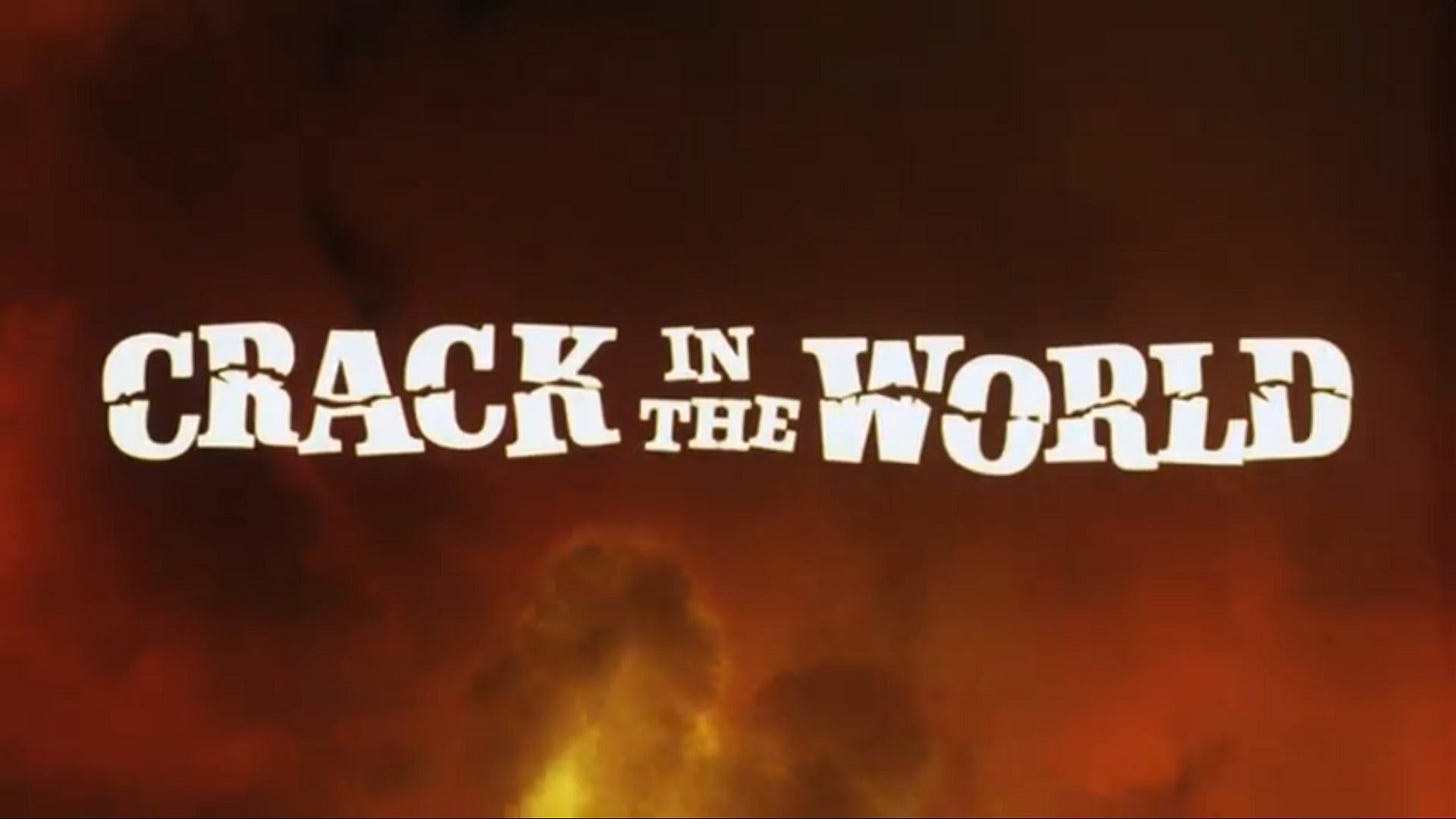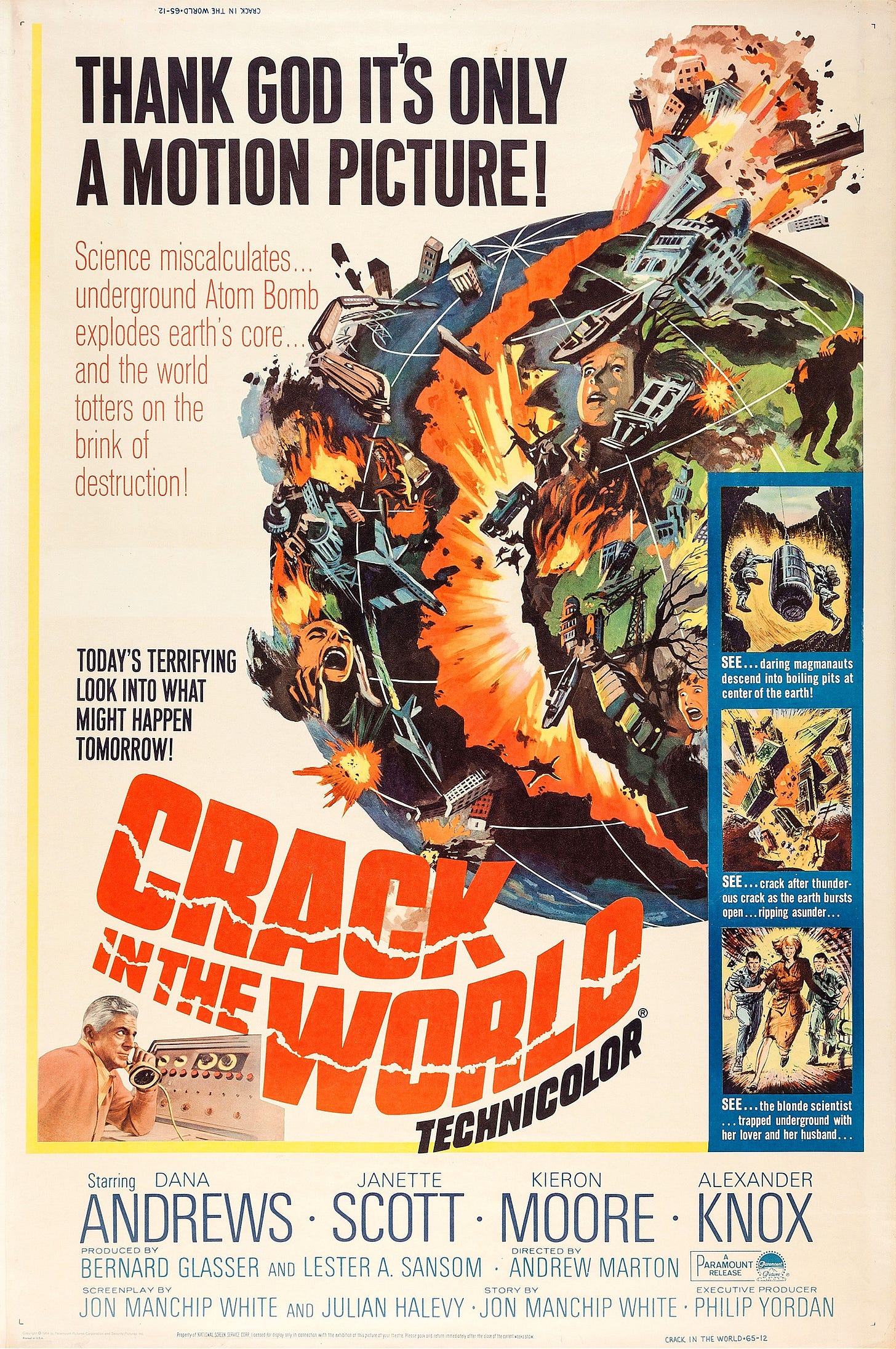PLOT
A scientist with a terminal disease is obsessed with drilling through the Earth’s core, to the point of using a nuclear bomb to achieve his goal.
REVIEW
When you’ve seen enough movies, you stop expecting them to be perfect. Very few of them are. Even the best films are often flawed in one way or another. And quite often, believability is an issue.
Oddly enough, “Crack in the world” was deemed believable by the press at the time of its release. Perhaps it helped that a geologist served as a technical advisor.
I say ‘oddly’ because there were many aspects of the film that bugged me. Granted, I’m no scientist, but still... I find it hard to believe that anyone would think it a good idea to shoot a nuclear head at the center of the Earth. And then, when things don’t go quite as planned, shoot a second bomb to curtail the effects of the first.
Oh, yeah, what a splendid idea.
But okay, let’s backtrack a bit and start at the beginning.
Before we delve in too deep, I’d like to say a few words about the cast. It’s a bit of a mixed bag. On the good side, you have Dana Andrews and Janette Scott who do a decent enough job with the material they are given. On the bad side, there’s Kieron Moore. It’s not so much that he is lacking, it’s more like he doesn’t feel right for the part. The guy looks more like a soldier or a cop than he does a scientist. He’d be perfect for a mercenary-type character.
Ironically, the best acting came from a minor character—John Masefield, played by Peter Damon.
Aside from the more obvious issues I mentioned above, there are other troubling elements. For instance, Sorenson is dying, and there are physical signs of this—bandages, and more and more of them. Yet, no one ever seems to question this, as if everything was fine. The only exception is when his wife, early in the movie, comments about how his rashes are getting worse (he has told no one about his illness), but then no further mentions are made.
Wikipedia states that Sorenson is dying from cancer, but there is no mention of cancer in the film. In fact, what exactly is killing him is never specified. All we know is that he’s trying to treat the issue with radiation and that it’s not working.
There are some clichés, too. When a character asks “Is there anything we can do?” Rampion answers “Pray!” The love triangle between him and the Sorensens can also be viewed as a cliché, though it is only superficially addressed.
So I’ve mentioned the two nuclear devices, but the madness doesn’t end there. There’s a scene where they must go down into an active volcano to launch that second bomb... uh, what? I’m sure nothing could possibly go wrong there.
The other issue I have with this whole nuclear thing is that they never even mention the risk of radioactive fallout. All they seem concerned about is how the bombs will break the crust and affect the tectonic plates, with a significant risk of destroying the planet. I’ll grant you that’s major stuff, but I find it odd they wouldn’t even mention radioactivity. This film was made only two decades after the atomic bombings of Hiroshima and Nagasaki. You’d think the writers and crew would remember something about that.
And let’s talk about that volcano. It seems to just stick out of the ocean some distance off the coast of an island... is that a thing now?
If you think that’s all, you’re sorely mistaken.
Let’s say you’re in the middle of a massive earthquake, with everything falling apart around you—walls, buildings, roads... Would you ride an elevator down to the depths of the earth? I know I wouldn’t. And get this, they ride it back up too! Okay, it isn’t exactly a joyride, but still... Madness, I tell you!
I mean, sure, that’s the type of stuff heroes do, I’ll grant you that. But when you show things breaking apart all around the characters, and then nothing happens while they ride that elevator down, that... well, it’s just cringe-worthy material. Of course, the writers needed the elevator whole so the characters could go back up. And that’s when things go awry. Because they had to, I guess.
And even then... When that elevator breaks, the characters must climb up the shaft. It’s not exactly a smooth climb, but it doesn’t seem anywhere near as insane as it should be, considering what was shown before.
Despite all these flaws, the film does a decent job of keeping you entertained. However, I doubt it will leave a lasting impression.
It’s that kind of movie you quickly watch and quickly forget.
—
Have you seen this film? What did you think of it?
What is your favorite disaster movie?
Let us know in the comments!
TRIVIA NOTES
Hungarian-born Andrew Marton was an American director whose films had a strong focus on nature and adventure. Among his credits are “King Solomon’s mines” (the 1950 version), “Storm over Tibet,” and “It happened in Athens.” He was also one of the three directors of the classic 1962 war film “The longest day”—the other two were Ken Annakin and Bernhard Wicki. His work with producer Ivan Tors led to the creation of two popular adventure shows: Flipper and Daktari. He also worked as a second unit director on William Wyler’s “Ben-Hur” (1959), Joseph L. Mankiewicz’s “Cleopatra” (1963), and Brian G. Hutton’s “Kelly’s heroes” (1970).
Bernard Glasser had previously produced “Return of the fly”—the 1959 sequel to the popular “The fly”—and the Sci-Fi classic “The day of the Triffids.” For Marton, he also produced “The thin red line,” a 1964 war film. He also did a syndicated adventure show Assignment: underwater that ran for one season (1960-61) of 39 episodes.
The peak of Dana Andrews’ career was in the 1940s when he was often cast as the leading man—most notably in Otto Preminger’s classic film noir “Laura” (1944). He also starred in “Fallen angel,” “The best years of our lives,” “Canyon passage,” and “The iron curtain.” Guest-starring bits on television include episodes of The Twilight Zone, Ironside, Ellery Queen, The love boat, and Falcon Crest. He served as president of the Screen Actors Guild from 1963 to 1965.
Janette Scott was the daughter of British actress Thora Hird. Her credits include “Helen of Troy” (she played Cassandra), “The Devil’s disciple,” “School for scoundrels,” “The day of the Triffids,” and “Bikini paradise” (where she reunited with Kieron Moore). She retired from acting after marrying singer Mel Tormé in 1966.
Canadian actor Alexander Knox began his career on stage in Boston, before moving to London where he made his film debut. In 1944, he went to Hollywood and starred as President Woodrow Wilson in Darryl F. Zanuck’s “Wilson.” His time there was short, however, as the rise of McCarthyism forced him to flee back to the UK. His other notable roles include “The Vikings” (1958), “Modesty Blaise” (1966), and the mini-series Tinker Tailor Soldier Spy (1979). He also guest starred in an episode of The Saint.
CREDITS
Directed by Andrew Marton.
Screenplay by Jon Manchip White & Julian Halevy, based on a story by Jon Manchip White.
Produced by Bernard Glasser & Lester A. Sansom.
Music by Johnny Douglas.
Cinematography by Manuel Berenguer.
Edited by Derek Parsons.
Starring Dana Andrews as Dr. Stephen Sorensen, Janette Scott as Dr. Maggie Sorensen, Kieron Moore as Dr. Ted Rampion, Alexander Knox as Sir Charles Eggerston, Peter Damon as John Masefield, Gary Lasdun as Markov, Mike Steen as Steele, Sydna Scott as Angela, Todd Martin as Simpson, Jim Gillen as Rand, Alfred Brown as Dr. Bill Evans, Emilio Carrere, John Karlsen as Dr. Reynolds, Ben Tatar as Indian Ambassador.
Produced by Security Pictures.
Distributed by Paramount Pictures.
Released on February 24, 1965.
Running time: 106 minutes.
Genre: Disaster.
—
Share your thoughts in the comments! I would love to hear them.
If you enjoyed this review, please feel free to forward it to your friends or to share it on social media.
And don’t forget to like by clicking the little heart below this post ;)
Thank you!
—
Text (c) 2023 by Alex S. Garcia.
Header image: screenshot of the film’s title card.
Film poster from impawards.





